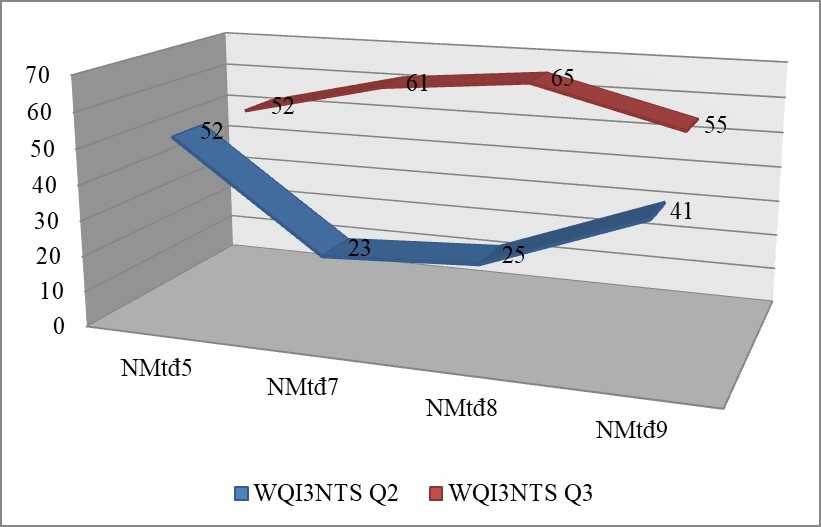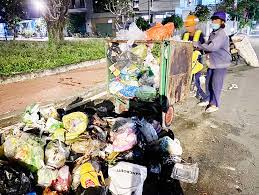14. SOURCE IDENTIFICATION AND POTENTIAL RISK OF HUMAN HEALTH OF PM10 - BOUND POLYCYCLIC AROMATIC HYDROCARBONS FROM RICE STRAW OPEN BURNING IN MEKONG, VIETNAM
Giới thiệu
In this study, we dealt with variations of PM10 - bound polycyclic aromatic hydrocarbons (PAHs) to estimate the human health risk and identify their possible sources from rice straw open burning (RSOB). Field experiments were conducted in the middle of the rice fields, away from roads, residential and industrial activities, to collect particle-bound PAHs emitted from rice straw open burning in the Mekong Delta. 16 PAHs in extracted solution samples were quantified using GC/MS - MS Thermo TSQ9000. The results showed that the ratio of B[a]P/B[k]F, B[a]P/∑COMB and Fth/(Fth + Pyr) could be used as diagnostic ratios for the identification of sources from RSOB. In addition, the carcinogenic risk of PAHs on PM10 (ECR - B[a]PTEQ) on burning samples was 238 times higher than the ECR index (10-4 ng.m-3). These results prove that the RSOB emitted PAHs compounds on PM with a high risk to human health. ECR - B[a]PMEQ emitted from RSOB have a very high potential for mutagenicity. These results can be used to make a scenario about the risk of PAHs arising from RSOB for policymaking in air quality management.
Toàn văn bài báo
Trích dẫn
[2]. Rogelj J., O. Geden, A. Cowie and A. Reisinger (2021). Net - zero emissions targets are vague: three ways to fix. Nature 591, 365 - 368. Doi: https://doi.org/10.1038/d41586-021-00662-3.
[3]. Shen P. and N. Liorb (2016). Vulnerability to climate change impacts of present renewable energy systems designed for achieving net-zero energy buildings. Energy, 114, 1288 - 1305. https://doi.org/10.1016/j.energy.2016.07.078.
[4]. Chen J., Li C., Ristovski Z., Milic A., Gu Y., Islam M. S., Wang S., Hao J., Zhang H., He C., Guo H., Fu H., Miljevic B., Morawska L., Thai P., Lam Y. F., Pereira G., Ding A., Huang X. and Dumka U. C. (2017). A review of biomass burning: Emissions and impacts on air quality, health and climate in China. Sci Total Environ, 579, p. 1000 - 1034, 10.1016/j.scitotenv.2016.11.025.
[5]. Kim K. H., Jahan S. A., Kabir E. and Brown R. J. (2013). A review of airborne polycyclic aromatic hydrocarbons (PAHs) and their human health effects. Environ Int, 60, p. 71 - 80, 10.1016/j.envint.2013.07.019.
[6]. Maffia Jacopo, Dinuccio Elio, Amon Barbara and Balsari Paolo (2020). PM emissions from open field crop management: Emission factors, assessment methods and mitigation measures - A review. Atmospheric Environment, 226, p. 117381, 10.1016/j.atmosenv.2020.117381.
[7]. Zhao Hongmei, Zhang Xuelei, Zhang Shichun, Chen Weiwei, Tong Daniel and Xiu Aijun (2017). Effects of agricultural biomass burning on regional Haze in China: A review. Atmosphere, 8(12), 10.3390/atmos8050088.
[8]. Wu J., Kong S., Zeng X., Cheng Y., Yan Q., Zheng H., Yan Y., Zheng S., Liu D., Zhang X., Fu P., Wang S. and Qi S. (2021). First high-resolution emission inventory of Levoglucosan for biomass burning and non-biomass burning sources in China. Environ Sci Technol, 55(3), p. 1497 - 1507, 10.1021/acs.est.0c06675.
[9]. Jenkins. Bryanm, Danieljones Scottq. Turn and Robert Williams (1996). Emission factors for polycyclic aromatic hydrocarbons from biomass burning. Environmental Science and Technology. 30, p. 2462 - 2469. https://doi.org/10.1021/es950699m.
[10]. Nguyen Thi Kim Oanh, Lars Betz Reuterg and Nghiem Trung Dung (1999). Emission of polycyclic aromatic hydrocarbons and particulate matter from domestic combustion of selected fuels. Environ. Sci. Technol., 33, p. 2703 - 2709.
[11]. Lewtas J. (2007). Air pollution combustion emissions: Characterization of causative agents and mechanisms associated with cancer, reproductive and cardiovascular effects. Mutat Res, 636(1 - 3), p. 95 - 133, 10.1016/j.mrrev.2007.08.003.
[12]. Sarigiannis DAlpha, Karakitsios S. P., Zikopoulos D., Nikolaki S. and Kermenidou M. (2015). Lung cancer risk from PAHs emitted from biomass combustion. Environ Res, 137(p. 147 - 156, 10.1016/j.envres.2014.12.009.
[13]. Tuyen Le Huu, Tue Nguyen Minh, Suzuki Go, Misaki Kentaro, Viet Pham Hung, Takahashi Shin and Tanabe Shinsuke (2014). Aryl hydrocarbon receptor-mediated activities in road dust from a metropolitan area, Hanoi, Vietnam: Contribution of polycyclic aromatic hydrocarbons (PAHs) and human risk assessment. Science of the Total Environment, 491 - 492, p. 246 - 254. https://doi.org/10.1016/j.scitotenv.2014.01.086.
[14]. Skupińska K., Misiewicz I. and Kasprzycka-Guttman T. (2004). Polycyclic aromatic hydrocarbons: Physicochemical properties, environmental appearance and impact on living organisms. Acta Pol Pharm, 61(3), p. 233 - 40.
[15]. Tobiszewski M. and Namiesnik J. (2012). PAH diagnostic ratios for the identification of pollution emission sources. Environ Pollut, 162, p. 110 - 119, 10.1016/j.envpol.2011.10.025.
[16]. VGSO (2020). Statistical yearbook of Vietnam. Hanoi, Vietnam. In Statistical yearbook of Vietnam General Statistics Office. https://www.gso.gov.vn/en/data-and-statistics/2020/09/statistical-yearbook-2019/.
[17]. Kim Oanh Nguyen Thi, Ly Bich Thuy, Tipayarom Danutawat, Manandhar Bhai Raja, Prapat Pongkiatkul, Simpson Christopher D. and Sally Liu L. J. (2011). Characterization of particulate matter emission from open burning of rice straw. Atmospheric Environment, 45(2), p. 493 - 502. https://doi.org/10.1016/j.atmosenv.2010.09.023.
[18]. Vu Duc Nam, Phung Thi Lan Anh, Le Minh Thuy, Nguyen Lan Anh, Nguyen Thi Huong, Pham Thi Loan Ha, Doan Thi Van Anh, Le Quang Huong, Nguyen Xuan Hung, Thi Nguyen Thao, Nguyen Phuong Thanh, Chu Dinh Binh and Thuyet Dang Quoc (2021). Analysis of polycyclic aromatic hydrocarbon in airborne particulate matter samples by gas chromatography in combination with Tandem mass spectrometry (GC - MS/MS). Journal of Analytical Methods in Chemistry, 2021, p. 1 - 10, https://doi.org/10.1155/2021/6641326.
[19]. Phuong Pham Thi Hong, Nghiem Trung Dung, Thao Pham Thi Mai, Pham Chau Thuy, Thi Tham Trinh and Thanh Dien Nguyen (2021). Impact of rice straw open burning on local air quality in the Mekong delta of Vietnam. Atmospheric Pollution Research, 12(11), p. 101225. https://doi.org/10.1016/j.apr.2021.101225.
[20]. Nisbet Ian C.T. and LaGoy Peter K. (1992). Toxic equivalency factors (TEFs) for polycyclic aromatic hydrocarbons (PAHs). Regulatory Toxicology and Pharmacology, 16(3), p. 290 - 300. https://doi.org/10.1016/0273-2300(92)90009-X.
[21]. Durant J.L., Lafleur A.L., Busby W.F., Jr., Donhoffner L.L., Penman B.W. and Crespi C.L. (1999). Mutagenicity of C24H14 PAH in human cells expressing CYP1A1. Mutat Res, 446(1), p. 1 - 14, 10.1016/s1383-5718(99)00135-7.
[22]. Nguyen, D. N. & Nguyen, T. (2004). Climate and climate resources in Vietnam. Agricultural Publisher.





